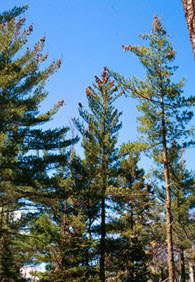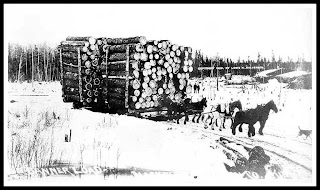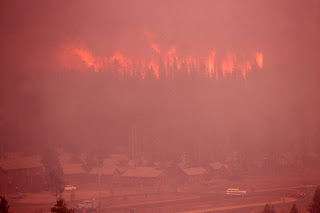Disaster at Hinckley
The story of what happened in Hinckley, Minnesota in the late summer of 1894 is a many sided tale. While being a story of unimaginable disaster it's also a story of what went wrong and why it went wrong. In today's modern age, what occurred in Hinckley is almost impossible to duplicate. The answers to the what's and why's of 1894 Hinckley are why we are a much safer society today. Hinckley in the last part of the 1800's was in a sense the victim of a collision between westward economic expansion and the limits of technology.
A Growing Lumber Town
The sawmill at left is typical of one's located throughout the heavy forested areas of Minnesota and Wisconsin during the last few decades of the 19th century.
Hinckley, in northern Minnesota, is located about halfway between St. Paul and Duluth. The scene in 1884 was that of a thriving and growing town with a population around 1,500.
The town was served by two railroads and had a sawmill/lumberyard employing some 200 men. The commercial enterprises also included hotels, a cigar shop, a drugstore, doctors offices and other retail establishments. Immigrants were a large percentage of the population and most came from the northern European countries. It was a busy and bustling town and offered people a chance to make a good living and raise families. Trains were comin and going at all times of the day and night with passengers and freight. It really was a great place to call home.
The White Pine Industry
Hinckley's economy was dependent on the white pine lumber industry. There was a tremendous need for this soft yet strong wood (pictured right) and the lumber barons did everything they could to produce as much as possible for a growing nation and for their own wealth.
Over the decades the lumber interests worked east to west through the country. In their wake they left many desolate and treeless areas. This was the era before forest management was recognized. Those who did recognize the need for careful harvesting of the forests were either ignored or silenced. The forest management concept not only identified the need for replanting but also addressed the problem of dried out branches, tree trunks, pine needles and pine cones and everything else left behind that turned into fuel for fires. This was also an era where not much was known about forest fires. Sawmills themselves added to the safety issue in as much as the saws were operated by steam power. This meant hot boilers.
Summer of 1894
The summer of 1894 was a particularly hot and dry one for the Minnesota region. Temperatures were averaging ten degrees above normal and a drought was in full force. Day after day there was a general haze and at times the faint smell of smoke could be encountered throughout the forests. Here and there small fires would be found and would be extinguished. In some cases it was simple combustion caused by the heat on dried out bark and branches on the forest floor. Other times it might be from steam locomotives traveling through a dry hot forest. In hindsight the message was clear. There was a combination of natural and man-made forces getting ready to collide.
The Early Days of Weather Forecasting
The picture at left shows a room full of weather service workers collecting data in the very early 1900's. There was no such operation in 1894. Weather observers simply collected data.
Occasionally a short term forecast could be issued but anything longer term was impossible. The people of northern Minnesota could not know when rain might come or when the temperatures might lower. In 1894, many people simply relied on some weather proverbs. Here are a few..."When the walls are unusually damp, rain is expected". "Much noise made by mice and rats indicate rain". "When deer are in gray coat in October expect a severe winter". Certainly not the same as the 21st century NOAA standards.
Today, we know that a fire requires fuel to survive. We also know that an excellent source of fuel for forest fires are dried out timber, branches, leaves, pine needles and cones and wood shavings piled up on the forest floor. All of these things were left behind by the lumber interests during the deforestation of 1894. Profits and speed trumped forest management.
Probably one of the foremost proponents of wise forest management in that era was a man named General Christopher Columbus Andrews, a civil war veteran and former ambassador to Sweden. During his time in Sweden he learned about the Swedish forest management system of selectively cutting and replanting. He deplored the way the American lumber industry left combustible waste on the forest floor and their indiscriminate cutting, leaving sparse landscapes in their wake. Towns were burned down and people killed by forest fires for decades. General Andrews thought that this destruction and carnage could be avoided. The General gave several speeches in the east on the topic but the lumber barons paid little heed.
The Right Mixture for Disaster
What happened in Hinckley, Minnesota on September 1st, 1894 was a result of poor forestry meeting a prolonged drought and record breaking high temperatures. The collision was so violent and the resulting fire so immense that the fire created it's own weather system. This is described as a firestorm. In 1894 that was an unknown. Today, in the age of airborne water tankers, we know that a large fire will take on a life of it's own. The picture below right shows what a firestorm looks
like. The one pictured occurred in 1988 at Yellowstone National Park.
A fire needs oxygen. During a firestorm the advancing fire draws in needed oxygen. Winds result. Vortex's can be created causing something referred to as a fire tornado. The picture below right shows what a fire tornado or whirlwind can look like. Another possible creation during a firestorm are tongues of flame shooting out in advance of the main fire line. These can extend 1,500-2,000 feet catching the trees on fire much ahead of where a fleeing population is trying to escape to and trapping victims. Much of this was reported about in the 1894 Hinckley fire. The details of what exactly causes these phenomena to happen is an interesting climate story in itself, too large to adequately explain in this story. What we know is that a firestorm will change the atmosphere dramatically.
You may also be interested in the Western Trips articles on the links below...
The Great Fire of 1910
The Great Fire and the Pulaski Tunnel Trail
The Fire That Couldn't Be Stopped
When the Hinckley fire erupted from the southwest on September 1st it was impossible to stop. Where exactly it began has never been positively determined. Most likely spontaneous combustion of dried out fuel caused by the extreme weather.
The first evidence of the approaching fire was the smell of smoke. Then the skies to the south and southwest became darker and the approaching fire took on a sound like a roar. Ash began falling in and around Hinckley in some cases starting other fires. People tried to escape to the north and northwest on whatever trains happened to be available. Some loaded their possessions onto horse carts and headed north. They headed to streams and small ponds to escape the heat and flames. Some huddled in open fields away from the forest and covered themselves with blankets to escape the thick smoke.
The fire was of such intensity that it literally moved too fast for many to escape it's grip. People and animals were overtaken by it's flames. The people truly had not seen what was coming at them through all the smoke and murk. Rescue trains like the one pictured left tried to reach Hinckley from the north but some were turned back by what they saw up ahead. The fire also burned bridges and trestles causing rescue trains to halt. To add to all this, the firestorm destroyed telegraph lines in the affected area thus shutting down most communication to the rest of the world. Train depot telegraph operator Thomas Dunn was quoted as saying, " I think I've stayed too long".
The fires that day also burned a portion of northern Wisconsin since their weather forecast was similar to Hinckley's. Dry, hot and no rain. The estimated death toll in Minnesota was put at 436 and at least 9 in Wisconsin. There were additional unaccounted for Native Americans that probably added to that figure.
Newspapers Report on the Disaster
Newspapers from around the country rushed reporters to the scene. If anything at all positive could have come out of this monster of a firestorm it was a further public awareness of the need to prevent similar disasters. The debate over proper forest management was again front and center.
There were massive fires before and after Hinckley such as the Great Fire of 1910 in the Montana/Wyoming region. That fire probably was the crowning event that finally moved the federal government to take the lead in promoting wise forest management. The establishment of forest rangers during the Theodore Roosevelt administration, although still being opposed by the lumber interests, was one example of this.
The images left show people fleeing from burning rescue trains as well as the aftermath of the town of Hinckley itself. When the fires burned themselves out, the task of recovering the dead and their burials began. Hinckley never fully recovered from the storm. Temporary shelters in the form of tents were erected for the survivors. Eventually these were replaced by more sturdy temporary housing and then little by little permanent structures were built. The economy never did recover primarily due to the railroads quietly moving their larger lines out of Hinckley and the extinction of lumbering employment. The immigration to the area virtually stopped.
Northern Minnesota is a beautiful part of America and if you are traveling through that area I would recommend a stop in Hinckley.
There are several memorials to the 1894 fire victims as well as the Hinckley Fire Museum which tells the story of the 1894 fire through artifacts and paintings. Stories from fire survivors have been passed down through generations and there have been reunions in Hinckley over the years by still living survivors.
This catastrophe affected many lives and there is much more to tell about what happened in Hinckley, Minnesota on September 1st, 1894. I know that a visit there would be a good learning experience about what it was like to live in a prosperous yet vulnerable lumber town in the late 1800's and how a community rebuilt itself after such an unthinkable disaster.
The websites below will give you more information about Hinckley and where to stop while there.
I would also recommend a very well written book on the subject and a real page turner, "Under A Flaming Sky" by author Daniel James Brown.
(Article copyright Western Trips. Photos and images in the public domain)
The Story of the Modern Day Smokejumpers
www.hmdb.org/marker.asp
www.museumsofmn.com/hinckley-fire-museum.html
www.tripsintohistory.com
View Larger Map










